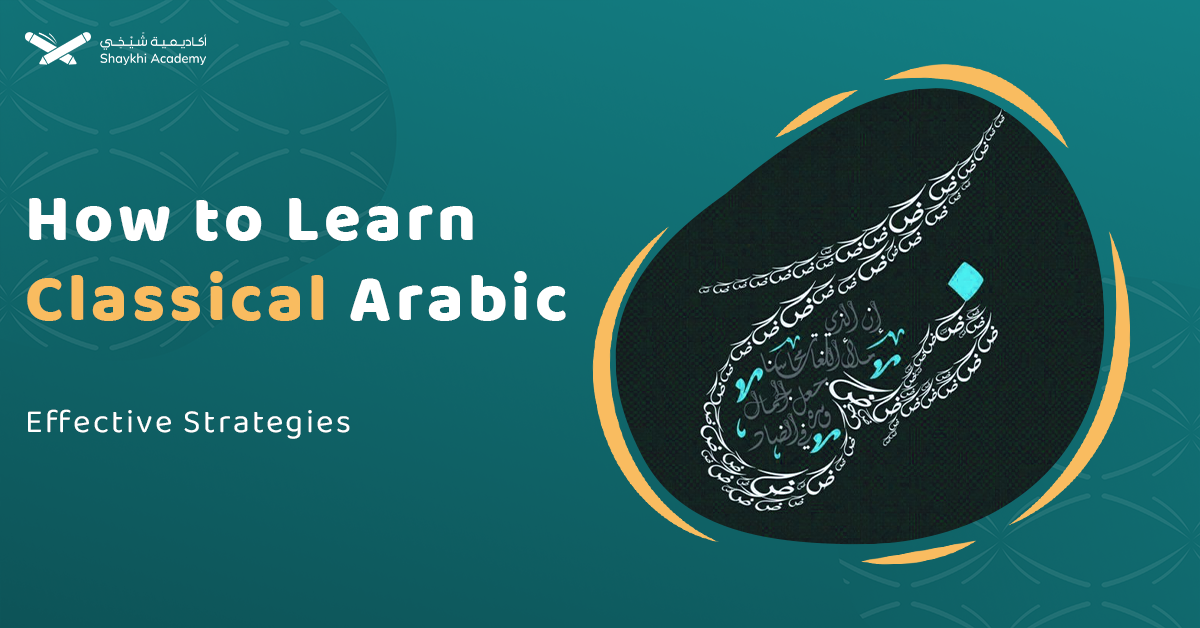To learn Classical Arabic, start by mastering the Arabic alphabet and basic grammar, avoiding shortcuts. Focus on understanding Arabic syntax and sentence structure, which are essential for both written and spoken communication. Incorporate listening and reading of simple texts to familiarize yourself with how grammar rules are applied.
Engage with classical texts such as the Quran, Hadith, and pre-Islamic poetry to deepen your knowledge. Regular practice, utilizing resources like online courses, tutors, and dictionaries, is essential. Patience and consistency are key, along with immersion in the language through continuous exposure and study.
Let’s discuss them in more detail:
How to Learn Classical Arabic?
Would you like to learn classical Arabic? Who wouldn’t want to learn the language of the Quran and Islamic heritage? It is a rich and beautiful language to learn. The learning process can be difficult but rewarding. Therefore, the learning process requires diligence and methodology, so we will provide tips and steps to complete the process.
1- Start with the basics of Classical Arabic
Begin by familiarizing yourself with the Arabic alphabet, as well as fundamental grammar and vocabulary. Avoid overwhelming yourself by taking on too much at once.
Learning Arabic by transcribing words is a common mistake, especially if you don’t first learn the Arabic alphabet. Try doing what you did about English learning. In school, it was structured around learning letters, forming words, forming sentences, and learning proper syntax and grammar. Taking shortcuts will only make the process more difficult.
2- Develop an initial comprehension of Arabic grammar and syntax.
Arabic syntax governs word order to ensure clear meaning, vital for understanding written and spoken Arabic. Incorrect syntax can distort meaning. Developed in the early Islamic period to interpret the Quran, it was first established by Abu al-Aswad al-Du’ali with Imam Ali’s guidance, later expanded by scholars like Sibawayh and Al-Farahidi. Mastering syntax is key to effective communication and fluency in Arabic.
To comprehend Arabic syntax, we need to be familiar with:
A. The basics of Arabic syntax
In order to comprehend Arabic syntax, we should first become acquainted with the basic concepts that underlie it. These are:
- Parsing: Figuring out the grammatical status of a word in a sentence, including nominative, accusative, genitive, or jussive.
- Construct: The state of a word that is permanent and doesn’t change with its position in the sentence.
B. The parts of speech in Arabic syntax
In Arabic, there are three main categories of words:
- Verbs: words that depict events or actions carried out by the subject
- Nouns: words used to describe things, people, and places.
- Particles: words used to connect nouns to verbs or sentences.
3- Put your attention to reading and listening.
To facilitate the process of learning the Arabic composition, some practical steps, such as
reading simple texts that help understand how the Arabic rules are applied in context. Listening to dialogues and talking to original speakers can improve the ability to use construction properly.
4- Gain knowledge of classical Arabic texts
Classical Arabic texts are considered a vast ocean of knowledge and learning from all perspectives, offering a broad and deep understanding of the Arabic language and its development. These texts are represented in:
A. The Quran
The Quran is the fundamental text of Islam. Reading the Quran helps you build a strong foundation in the Arabic language by understanding the verses and the depth of Quranic meanings.
B. Hadith
The Hadith and the Prophetic Sunnah are also sources of classical Arabic. They provide an opportunity to understand Islam through the words of Prophet Muhammad (PBUH) and to learn the Arabic language and its vocabulary.
C. Poetry and Islamic Literature
The richness of the Arabic language in terms of meanings and vocabulary is clearly reflected in pre-Islamic poetry (Jahiliyyah poetry).
5- Gaining proficiency in listening and speaking
To improve your Arabic proficiency, it’s important to speak with others. Finding a conversation partner can be challenging if you don’t have access to native speakers. Fortunately, modern technology can assist in solving that problem.
6- Learn to use the Arabic dictionary
This task is not as straightforward as it may sound. In an Arabic dictionary, words are generally arranged in three-letter roots. To find a word, it’s necessary to know its root and which letter it starts with, which is not necessarily the first letter in the word. The process of learning a dictionary can present challenges, but the earlier you master it, the easier and more enjoyable it will become.
7- Find a language tutor.
There are numerous online Arabic groups, and it has become more straightforward to locate tutors who can assist you with your studies. Utilize these resources to learn Arabic. The more practice you do, the more effective your learning will be.
Think about locating a tutor who can give you tailored guidance and aid you with particular areas where you’re having trouble learning Arabic in its various forms.
8- Patience and Consistency
Because of the complexity of the grammar and its vocabulary, the process of learning requires patience and consistency during understanding and slowly accepting progress, which helps the quality of learning because a good understanding of the basics takes time but will yield good results and study.
Regular daily practice and getting used to reading, writing, or speaking, even if for a short time, makes learning the language part of your daily routine and deepens understanding.
9- Become absorbed in the language.
A comprehensive immersion into the study, comprehension, and appreciation of the subtleties, vocabulary, and structures of a classical language, such as classical Arabic, Latin, or Sanskrit, provides a closer connection with the language and its legacy. Studying its grammar, literature, usage, and historical and cultural contexts enables a deeper understanding of its influence.
10- Never stop practicing.
Learning a new language requires increasing your exposure to it, which can be done by reading Quranic literature and reading literature from the past. Additionally, you can practice Arabic by listening to Arabic news and Quranic recitations to become familiar with the language.
11- Utilize diverse resources:
Incorporate various learning materials, including textbooks such as Al-Aujrumyya and Al-Madinah books, online courses such as Online Quranic Arabic Course, and videos. This approach will provide a comprehensive education and expose you to different teaching methods.
12. Practice regularly:
Dedicate a few minutes each day to practicing, as consistency is crucial when learning a new language.
Best Ways And Methods To Learn Classical Arabic
Learning classical Arabic is a pleasant experience, although it is not very easy. During learning, it is helpful to use more than one source of learning to stimulate and enrich the learning experience and provide an environment and a good understanding of learning. Here are some types of resources to consider:
1- Learn Classical Arabic online
The availability of structured courses, resources, and communities has made it easier and more effective to learn classical Arabic online. Shaykhi Academy provides a comprehensive Arabic language learning experience. To get started, here’s a guide:
- Classical Arabic Course: learn how to read and understand the language of the Quran.
- Arabic Group Classes: rich learning experience through increased engagement with diverse learners
- Learn Quranic Arabic online: learning the language within the context of understanding and reciting the Quran.
- Learn to Read Arabic: You can now learn how to read all sorts of Arabic texts guided by a group of professional native tutors.
- The Best Noorani Qaida: To unveil the beauty of the Quranic language, as well as experience the tranquility and peace you can get by fluently reciting the Holy Quran in Arabic.
- Intensive Arabic Course Online: designed for serious students aiming to enhance their Arabic proficiency in a short period, guided by a team of native Arab tutors.
- The Best Online Al Azhar Arabic Course By Azhari Tutors: Master the Azhar Arabic curriculum from home and prepare for your dream specialty at the prestigious University of Al-Azhar with the least effort.
2- Learn Classical Arabic Self-Study (E-Book):
If you want to learn to read a Quran book and receive a certificate of completion if they study it with one of Shaykhi’s teachers and pass all tests and exercises, the best choice is Al-Menhaj Book, which is categorized as a Learn to Read Quran book for beginners and is considered the first stage in your journey to learn to read the Quran.
Classical Arabic vs. Modern Arabic
Classical Arabic (Quranic Arabic) and modern standard Arabic are both forms of the Arabic language, but they are distinct from one another. If you’re interested in learning Arabic, here’s more detail on the differences between these two forms of Arabic and the usage of each one:
| Feature | Classical Arabic (Quranic Arabic) | Modern standard Arabic |
| Historical Context | Quranic Arabic is the Arabic that is used in the Quran and was used in the 7th century. It has a rich, classic style and employs a lot of rhetorical and poetic devices. | It is an advanced form of classic Arabic adapted to modern contexts and used in contemporary writing and formal speech. |
| Grammar and Syntax | There may be grammatical structures that are less prevalent or absent in modern Arabic, which may include different verb forms and sentence constructions. | The grammar structure has been simplified and standardized, resulting in an easier learning experience for learners. |
| Vocabulary | Consists of old vocabulary and expressions that may not be commonly used today, and some words are restricted to religious contexts. | Introduces new terminology and words that are related to modern life, technology, and contemporary issues. |
| Pronunciation | There are specific rules for pronunciation in Tajweed that are important for recitation. | Although it’s consistent in pronunciation, it doesn’t prioritize recitation rules as much. |
| Usage | The primary function is for religious purposes, including reading and recitation of the Quran and Islamic scholarship. | The use of it is a prevalent practice in the Arabic world, especially in media, literature, education, and formal communication. |
In the table, we reviewed the marked differences between ancient Arabic and modern Arabic.
Learn Classical Arabic Letters and Alphabet
The Arabic alphabet, which is also known as the language of ض (Dhad), is unique. Each letter is determined by where they’re located in the word, as they’re written and read from right to left. Learning the alphabet is the key to learning and mastering the Arabic language by focusing on the names, shapes, and sounds of these letters.
The Arabic alphabet has 28 letters that represent consonants. Alif (ا), waw (و), and yaa (ي) are three letters that can also be used as long vowels in some situations.
In the following table, we will show the alphabets, their pronunciation, and the way they are written in all possible situations in the word:
| Serial | letter | Transliteration | Pronunciation in Arabic | Pronunciation in English | Forms |
| 1 | أ | Āalif | أَلِف | Like A in ant | Isolated: اEnd: ـاMiddle: ـاInitial: ا |
| 2 | ب | bāĀ | بَاء | Like B in Boy | Isolated: بEnd: بMiddle: ـبـ Initial: بـ |
| 3 | ت | tāĀ | تَاء | Like T in Tall | Isolated: تEnd: ـتMiddle: ـتـInitial: تـ |
| 4 | ث | ThāĀ | ثَاء | Like the Th in Three | Isolated: ثEnd: ـثMiddle: ثـInitial: ثـ |
| 5 | ج | Jīm | جِيم | like the G in good or like the G in engine | Isolated: جEnd: ـجMiddle: ـجـInitial: جـ |
| 6 | ح | HāĀ | حَاء | Like the h in he but light in pronunciation | Isolated: حEnd: ـحMiddle: ـحـInitial: حـ |
| 7 | خ | ḰāĀ | خَاء | Like the Ch in the name Bach | Isolated: خMiddle: ـخEnd: ـخـInitial: خـ |
| 8 | د | dāl | دَال | Like the D in Door | Isolated: دEnd: ـدMiddle: ـدInitial: د |
| 9 | ذ | ḏāl | ذَال | Like the Th in The | Isolated: ذEnd: ـذMiddle: ـذInitial: ذ |
| 10 | ر | rāĀ | رَاء | Like the R in Rat | Isolated: رEnd: ـرMiddle: ـرInitial: ر |
| 11 | ز | zāy | زَاي | Like the Z in Zoo | Isolated: زEnd: ـزMiddle: ـزInitial: ـز |
| 12 | س | sīn | سِين | Like the S in Sea | Isolated: سEnd: ـسMiddle: ـسـInitial: سـ |
| 13 | ش | šīn | شِين | Like the Sh in She | Isolated: شEnd: ـشMiddle: ـشـInitial: شـ |
| 14 | ص | Sād | صَاد | Like the S in Sad but heavier in pronunciation | Isolated: صEnd: ـصMiddle: ـصـInitial: صـ |
| 15 | ض | Dād | ضَاد | Like the D in Dead but heavier in pronunciation | Isolated: ضEnd: ضMiddle: ـضـIsolated: ضـ |
| 16 | ط | TāĀ | طَاء | Like the T in Dead but heavier in pronunciation | Isolated: طEnd: ـطMiddle: ـطـInitial: ط |
| 17 | ظ | DhāĀ | ظَاء | Like the Z in Zorro but heavier in pronunciation | Isolated: ظEnd: ـظMiddle: ـظـInitial: ظـ |
| 18 | ع | Ayn | عَينٍ | Like the A sound in the name Ali | Isolated: عEnd: ـعMiddle: ـعـInitial: عـ |
| 19 | غ | ğhayn | غَين | Like the Gh in Ghandi | Isolated: غEnd: ـغMiddle: ـغـInitial: غـ |
| 20 | ف | fāĀ | فَاء | Like the F in Foot | Isolated: فEnd: ـفMiddle: ـفـInitial: فـ |
| 21 | ق | qāf | قَاف | Like the Q in Queen | Isolated: قEnd: قMiddle: ـقـInitial: قـ |
| 22 | ك | kāf | كَاف | Like the C in Cat | Isolated: كEnd: ـكMiddle: ـكـInitial: كـ |
| 23 | ل | lām | لاَم | Like the L in Life | Isolated: لEnd: لـMiddle: ـلـInitial: لـ |
| 24 | م | mīm | مِيم | Like the M in Moon | Isolated: مEnd: ـمMiddle: ـمـInitial: مـ |
| 25 | ن | nūn | نُون | Like the N in No | Isolated: نEnd: ـنMiddle: ـنـInitial: نـ |
| 26 | ه | hāĀ | هَاء | Like the H in Hat | Isolated: هEnd: ـهMiddle: ـهـInitial: هـ |
| 27 | و | wāw | وَاو | Like the W in WAW! | Isolated: وEnd: ـوMiddle: ـوInitial: و |
| 28 | ي | yāĀ | يَاء | Like the Y in You | Isolated: يEnd: ـيMiddle: ـيـInitial: يـ |
Learn Classical Arabic With Native Teachers at Shaykhi Academy
Become proficient in classical (Quranic) Arabic online with the help of native Arab tutors, flexible schedules, and interactive lessons. Students can acquire key concepts such as grammar, vocabulary, and Tajweed.
Shaykhi Academy offers opportunities to learn Arabic reading, writing, and listening skills, as well as Arabic grammar. Additionally, all instructors are native Arabic speakers and have experience teaching others.
Why Shaykhi Academy?
- Expert Native Tutors: Learn from highly qualified native Arabic speakers.
- Flexible Scheduling: Tailor your classes to fit your busy life.
- Affordable Learning: Access top-quality education at a price that suits you.
- Global Access: Study from anywhere in the world.
Explore Our Arabic Courses:
- Noorani Qaida: Build a strong foundation in Quranic Arabic.
- Comprehensive Arabic Courses: Master the Arabic language, from beginner to advanced levels.
- Fusha Arabic Classes: Delve into Modern Standard Arabic, the key to understanding literature, media, and formal communication across the Arab world.
- Quranic Arabic Course: Enhance your connection with the Quran by learning the language in which it was revealed.
Start Your Arabic Journey Today! Whether you’re just starting or looking to deepen your knowledge, Shaykhi Academy is here to support your journey. Book your free trial now and begin your path to Arabic mastery!

Conclusion
If your goal is to read and understand the Quran in its original language and delve into Islamic texts and scholarship, learning classical Arabic is essential. However, if you aim for practical communication, Modern Standard Arabic is the better choice, as it is used in news, literature, and formal settings, serving as a common ground among speakers of different Arabic dialects.
If you’re interested in both, you can start with Modern Standard Arabic to build a solid foundation and then transition to Quranic Arabic to deepen your understanding of religious texts. You may be surprised to learn that Arabic characters make up the written alphabet for several other languages, including Persian, Malayalam, Urdu, Central Kurdish, Pashto, and Uyghur.
Therefore, by learning the Arabic alphabet, you’ll also build a reading base for these other languages! Reading and writing in Arabic using the Arabic alphabet is not as challenging as it may seem, though English speakers might find the unfamiliar Arabic characters intimidating at first.

















































